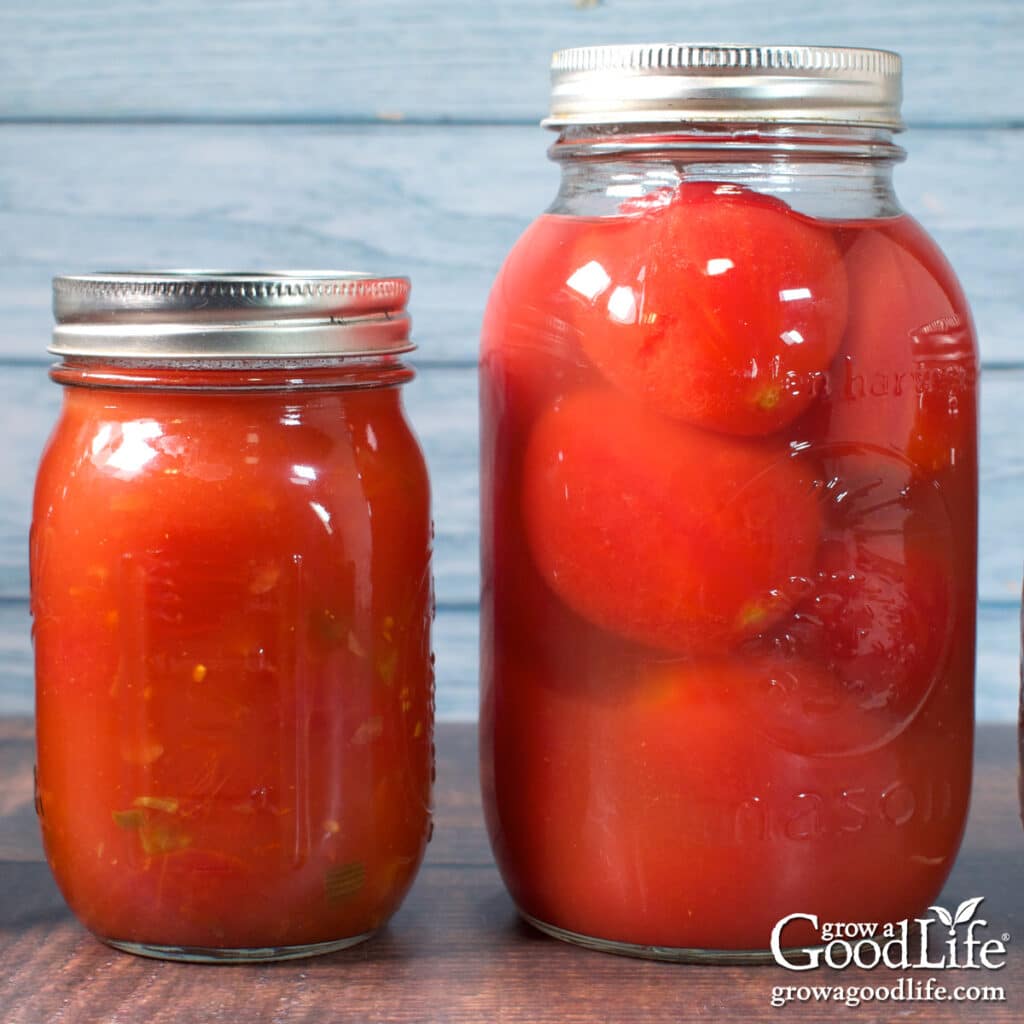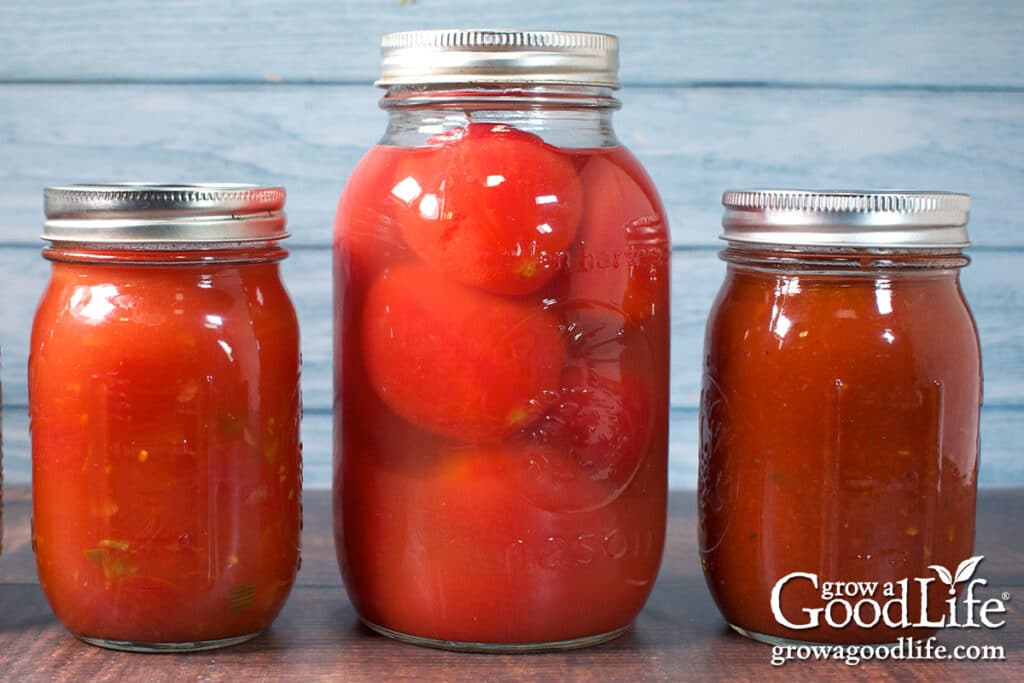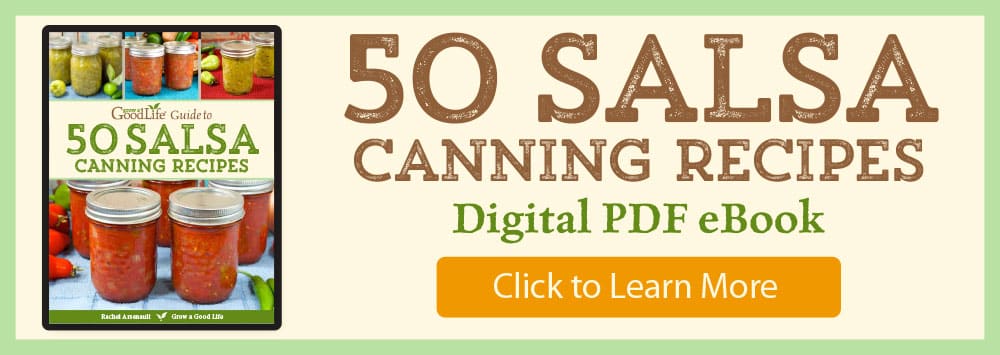How to Safely Modify Tomato Canning Recipes
This post may contain affiliate links, which means that I may receive a commission if you make a purchase using these links. As an Amazon Associate I earn from qualifying purchases.
Wondering how to modify tomato canning recipes safely? Discover which adjustments you can make, including substitutions for salt, herbs, and types of tomatoes, without jeopardizing food safety.

Tomatoes are one of the most popular home-canned foods. They are versatile, delicious, and a staple in so many recipes. Whether you’re preserving whole tomatoes, simmering down a sauce, or preserving tomato puree, canning tomatoes is a great way to enjoy homegrown flavor all year long.
When it comes to safely canning tomatoes, following a lab-tested, safe canning recipe is important. That’s because tomatoes fall right on the edge between high-acid and low-acid foods. Even small changes can make your jars unsafe to store at room temperature, such as adding extra vegetables or skipping the acid. Following tested recipes ensures the final product is acidic enough to prevent the growth of Clostridium botulinum, the bacteria that causes botulism.
But what if you want to customize the flavor or adjust the ingredients? The good news is there are some changes you can safely make.
In this article, we’ll explain what ensures the safety of tomato canning recipes and share tips for adjusting ingredients within recommended guidelines. This will help you preserve your harvest with confidence.
This article is part of our series on making safe changes to home canning recipes. For a broader look at safe canning substitutions, visit our Safe Changes to Home Canning Recipes page.
Why Safety Matters When Canning Tomatoes
Tomatoes walk a fine line when it comes to acidity. While some varieties are naturally acidic enough for water bath canning, others may have lower acid levels that fall into the danger zone for botulism. The growing environment, weather, and soil can also influence the fruit’s acidity level.
That’s why trusted sources like the Ball Canning, National Center for Home Food Preservation (NCHFP), and university extensions recommend adding acid to tomato products unless the recipe is designed and tested to be pressure canned. Harmful bacteria can survive and grow in sealed jars without this added acid.
It’s also important to understand that safe canning recipes aren’t just about ingredients. Factors such as the texture of the food, the preparation method, jar size, headspace, and processing time all affect how evenly heat can penetrate and eliminate pathogens. That is why following lab-tested canning recipes developed through rigorous testing is recommended to ensure that the final product can be safely stored after processing without refrigeration.
While there is some flexibility in tomato canning recipes, not every swap is safe. Next, we’ll go over what changes you can make to ensure your preserved tomatoes remain delicious and safe to eat.

Safe Changes You Can Make to Tomato Canning Recipes
When it comes to canning tomatoes, you can make a few ingredient modifications to personalize your recipes without compromising safety. To ensure the information in this article is accurate, I have researched the latest guidelines from reputable university extension offices. You can find these resources at the end of the article.
Tested canning recipes are carefully developed to ensure safety, especially for tomatoes, which sit right on the edge of the safe acidity range for water bath canning. While it’s important not to stray too far from trusted recipes, you can make several ingredient changes without risking food safety.
Here are safe modifications you can use to customize your canned tomato recipes:
Swap Tomato Varieties
You can safely substitute different types of tomatoes in tested canning recipes, including paste, slicing, heirloom, cherry, or even green, unripe tomatoes. Each type brings its own qualities to the sauce, affecting thickness, flavor, and overall yield.
- Paste or Plum Tomatoes: These varieties, such as Roma or San Marzano, have dense flesh, fewer seeds, and lower moisture content. They produce a thicker sauce with less simmering and give you a higher yield per pound.
- Slicing Tomatoes: Juicier and more watery, slicers like Beefsteak or Big Boy make a thinner sauce unless simmered for longer to reduce the liquid. They work well in canning recipes but may result in a lighter yield and require more cooking to thicken.
- Heirloom Tomatoes: Heirlooms offer rich, complex flavors and beautiful color variations. However, they can vary widely in moisture content and seediness, so expect a thinner sauce unless you simmer it down. They’re a great choice for flavor-forward sauces.
- Cherry or Grape Tomatoes: These small tomatoes are sweet and flavorful but high in water content and seeds. They can be used in sauce, but you’ll need more time to cook them down. Consider blending them with paste tomatoes for better texture.
Change the Type of Onion
You can safely substitute different types of bulb onions in tested tomato canning recipes as long as you use the same measured amount. Whether you choose yellow, white, red, or sweet onions, the flavor will vary slightly, but the safety of the recipe remains intact.
- Yellow Onions: These are the most commonly used onions for canning. They have a bold, balanced flavor that mellows and sweetens when cooked, making them a great all-purpose choice for tomato sauces.
- White Onions: Milder and slightly sharper than yellow onions, white onions have a clean, crisp flavor. They’re ideal if you prefer a lighter onion presence in your sauce.
- Red Onions: These onions bring a bit of sweetness and a subtle peppery bite. While their color will fade during cooking, they can still add depth to your sauce flavor.
- Sweet Onions (like Vidalia, Walla Walla, or Maui): These varieties are naturally high in sugar and have a delicate, mild flavor. They work well in tomato sauces where you want a gentle sweetness and less bite.
Adjust Seasonings and Herbs
You can customize the seasonings and herbs within reason. While flavors may change slightly during storage (sage, for example, can become bitter), it’s safe to:
- Swap dried herbs: Exchange one dried herb for another in equal amounts, such as 1 teaspoon of dried oregano for 1 teaspoon of dried parsley.
- Swap fresh herbs: If a recipe calls for fresh herbs, you can switch them in equal amounts. For example: 1 tablespoon chopped parsley for 1 tablespoon chopped basil.
- Add dried herbs or spices: Add up to 1 teaspoon per pint or 2 teaspoons per quart, such as onion powder, garlic powder, crushed red pepper, or additional dried Italian seasoning.
- Add fresh herbs to jars: Add up to 2 small sprigs of fresh herbs to each jar, such as a sprig of basil in tomato sauce.
Adjust Sweetness
- Add sugar: You can add sugar to taste to balance the acidity of tomato products. A common guideline is 1 teaspoon per pint or 2 teaspoons per quart.
- Reduce or omit sugar: Sugar is optional in many tomato recipes and can be reduced or left out entirely.
Reduce or Omit Ingredients Used for Flavor
These ingredients are used for taste and can be adjusted:
- Salt: Feel free to reduce or omit.
- Garlic: Can be reduced or left out.
- Onions: May be reduced or omitted, but do not increase the amount.
Choose Your Acid
Most tomato canning recipes require added acid to ensure they are safe for water bath canning. You have two safe options to choose from:
- Bottled Lemon Juice: This is a popular choice, though it may add a slight lemony tang to your tomatoes or sauces. You can add some sugar to balance the flavor. Be sure to use bottled lemon juice (not fresh) to ensure the acidity is consistent and safe for canning
- Powdered Citric Acid: This is a flavorless alternative that won’t alter the taste of your finished product. Use only food-grade citric acid, such as Mrs. Wages or a similar brand.
These small adjustments let you personalize your tomato canning recipes without compromising safety. However, it’s just as important to understand which changes aren’t safe, especially when it comes to acidity, vegetables, and density. Let’s take a look at the modifications you should avoid.
Unsafe Changes to Avoid
While some minor tweaks are ok, other changes can make your jars unsafe for shelf storage and increase the risk of foodborne illness. Here are the most important things not to do when canning tomatoes at home:
Don’t Increase Low-Acid Ingredients
Ingredients like fresh herbs, onions, garlic, peppers, carrots, celery, and other vegetables are low in acid. Increasing the amounts beyond what’s listed in a tested recipe can lower the overall acidity of the product, creating the perfect environment for Clostridium botulinum, the bacteria that causes botulism.
Don’t Skip or Reduce the Required Acid
Tomatoes are right on the edge of safe acidity. That’s why most tested recipes require adding acid to each jar. Always include the full amount of acid called for in the recipe. You can add a little sugar to balance the flavor:
- Add 1/4 teaspoon of citric acid or 1 tablespoon of bottled lemon juice per pint
- Add 1/2 teaspoon of citric acid or 2 tablespoons of bottled lemon juice per quart
Don’t Thicken or Add Tomato Paste Before Canning
Thick sauces can slow heat penetration, which may prevent the center of the jar from reaching a safe temperature. Avoid thickening your tomato mixtures before canning. Instead, add tomato paste and simmer to thicken after opening the jar to achieve the desired texture.
Don’t Puree Unless the Recipe Says So
Pureeing changes the texture and density of your tomato product. If you’re using a recipe designed for chopped, whole, or crushed tomatoes, don’t run them through a food mill, blender, or food processor unless the recipe specifically calls for it.
Don’t Skip Peeling the Tomatoes
Peeling is an essential step in safe tomato canning. Most tested recipes require removing the tomato skins, cores, and sometimes the seeds. The peels add unwanted texture and may harbor pathogens that may not be eliminated during processing. Peel your tomatoes to maximize safety and product quality.
Don’t Change the Tomato Prep
If the recipe says to quarter tomatoes, don’t dice them. The size and shape of the tomato pieces affects how heat moves through the jar. For example, there is no tested recipe for safely canning diced tomatoes at home because the density prevents even heat distribution.
Don’t Add Oil Unless the Recipe Includes It
Oil can coat food particles, trap bacteria, and interfere with heat penetration during processing. While a few tested recipes (like Seasoned Tomato Sauces) safely include oil, it’s important not to add it unless it’s part of the original, tested formula.
Avoiding these risky modifications will ensure your home-canned tomatoes are safe, shelf-stable, and delicious. Now that we’ve covered what not to do let’s look at a few extra tips to help you get the best results from your tomato canning projects.
Additional Tips for Safe Tomato Canning
Even when you’re following a tested tomato canning recipe, a few extra precautions can help ensure a safe and successful batch. Keep these important tips in mind as you prep your tomatoes and gather your gear.
Choose a Trusted Recipe and Prepare Ahead
Always start with a lab-tested, safe tomato canning recipe. Read it through carefully before you begin to make sure you understand each step.
Gather all your ingredients and make sure your canning and kitchen equipment is clean, in good condition, and ready to go. Most importantly, set aside enough time so you’re not rushed. Canning is not something to squeeze in between errands or dinner!
Start with Good-Quality Tomatoes
Select firm, ripe tomatoes free from rot, bruises, insect damage, or signs of disease. Avoid overripe, mushy, or frost-damaged tomatoes, as these may have uneven acidity and could harbor pathogens that may not be destroyed during processing. Stick with freshly harvested tomatoes for the best flavor and safest results.
Use Non-Reactive Cookware for Tomato Prep
When working with tomatoes, it’s important to use non-reactive pans and bowls, such as stainless steel, enameled cast iron, or glass.
Tomatoes are high in acid, and when they come into contact with reactive materials like aluminum, copper, or cast iron, the acid can leach metal into the food. This can give the tomatoes a metallic or bitter taste and change the color of the fruit. Stick with non-reactive pots and bowls when preserving tomatoes.
Follow Preparation Instructions Closely
The way tomatoes are prepped matters. Always follow the instructions in your recipe exactly. For example:
- If the recipe says “10 cups of chopped, cored, and peeled tomatoes,” it means you should first prepare the tomatoes by coring, peeling, and chopping them. After that, measure out 10 cups of the chopped tomatoes using standard measuring cups.
- If the recipe calls for “5 pounds of tomatoes, cored, peeled, and chopped,” weigh the tomatoes first, then core, peel, and chop them.
These prep instructions are specific because that’s how the recipe was tested to ensure safe processing times.
Include the Acid
If your tomato canning recipe includes added acid, don’t skip it. It’s a critical safety step. Tomatoes are borderline in acidity, and acidification ensures the pH is low enough to prevent the growth of Clostridium botulinum, the bacteria that causes botulism.
While some pressure canning recipes, such as stewed tomatoes, tomato and zucchini mix, and spaghetti sauce, are safe without added acid, most home-canned tomato recipes require acidification. Don’t leave out the acid in recipes that call for it.
Use one of the following for each jar:
- 1 tablespoon bottled lemon juice per pint, or 1/4 teaspoon citric acid per pint
- 2 tablespoons bottled lemon juice per quart, or 1/2 teaspoon citric acid per quart
Important: Always use bottled lemon juice, not fresh. Bottled juice has a standardized acidity level that ensures safety. Fresh lemons vary too much to be reliable for canning.
Adjust for Your Altitude
Both water bath canning and pressure canning require adjustments based on your elevation. At higher altitudes, water boils at a lower temperature, which can prevent your jars from reaching the heat needed to safely destroy harmful bacteria.
All tested canning recipes are developed for elevations of 1,000 feet or lower. If you live above that, you’ll need to make altitude adjustments to ensure your food is processed safely.
You can easily find your elevation using What’s My Elevation, then refer to the adjustment guidelines for your canning method below:
Water Bath Canning Altitude Adjustments
- 1,001–3,000 ft: Add 5 minutes
- 3,001–6,000 ft: Add 10 minutes
- 6,001–8,000 ft: Add 15 minutes
- 8,001–10,000 ft: Add 20 minutes
Pressure Canning Altitude Adjustments
Adjust the pressure pounds as indicated below:
- Altitude 0-1,000 feet: Weighted Gauge = 10 pounds. Dial Gauge = 11 pounds.
- Altitude 1,001-2,000 feet: Weighted Gauge = 15 pounds. Dial Gauge = 11 pounds.
- Altitude 2,001-4,000 feet: Weighted Gauge = 15 pounds. Dial Gauge = 12 pounds.
- Altitude 4,001-6,000 feet: Weighted Gauge = 15 pounds. Dial Gauge = 13 pounds.
- Altitude 6,001-8,000 feet: Weighted Gauge = 15 pounds. Dial Gauge = 15 pounds.
- Altitude 8,001-10,000 feet: Weighted Gauge = 15 pounds. Dial Gauge = 15 pounds.
Final Thoughts
Canning tomatoes at home is a delicious way to preserve the flavors of your harvest, and with the right techniques, it’s easy to do so safely. By following lab-tested recipes and making only the recommended changes, you can enjoy the process while ensuring your jars are safe for storage. These minor adjustments allow you to personalize your jars without compromising safety.
Feel free to get creative with seasonings, herbs, and even tomato varieties to suit your taste. But when it comes to acidity and density, always stick to the tested recipes to ensure your home-canned tomatoes are both delicious and safe. If you’re unsure about a modification, freeze your batch instead of canning it.
With these simple tips, you’ll be on your way to preserving your tomatoes in a way that’s both safe and full of flavor.
Resources:
- Play it Safe! Safe Changes and Substitutions to Tested Canning Recipes. North Central Food Safety Extension Network (NCFSEN)
- Modifying Canning Recipes. South Dakota State University Extension.
- Let’s Preserve: Ingredients Used in Home Food Preservation. PennState Extension.
- What Can You Change in a Canning Recipe? PennState Extension.
- USDA Complete Guide to Home Canning. Part 3: Tomatoes and Tomato Products
- Ball Complete Book of Home Preserving
If you love salsa, consider adding our eBook, Grow a Good Life Guide to 50 Salsa Canning Recipes, to your resource library. This 72-page eBook is packed with a variety of delicious salsa recipes, including classic tomato salsas to roasted and grilled salsas to tomatillo and delicious fruit blends, all safe for water bath canning. It’s the perfect guide to help you preserve your garden harvests.

